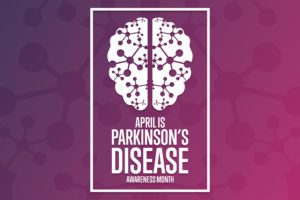Tips for Caring for Someone with Parkinson’s Disease
 April is Parkinson’s Awareness Month. While most people have a general idea about the physical symptoms of Parkinson’s, not as many understand what the day-to-day challenges of those who suffer from it can look like. It’s very helpful for those who have a loved one or are caring for someone with Parkinson’s to become knowledgeable about what to expect as the disease progresses.
April is Parkinson’s Awareness Month. While most people have a general idea about the physical symptoms of Parkinson’s, not as many understand what the day-to-day challenges of those who suffer from it can look like. It’s very helpful for those who have a loved one or are caring for someone with Parkinson’s to become knowledgeable about what to expect as the disease progresses.
Parkinson’s disease (PD) is a neurodegenerative disorder that affects predominantly dopamine-producing neurons in a specific area of the brain called substantia nigra. While genetic markers and environmental triggers can be contributing risk factors, the root cause is unknown. The end result, however, is that dopaminergic neurons gradually break down or die. As dopamine levels decrease, abnormal brain activity takes place, leading to impaired movement. People usually develop the disease around age 60 or older, and men are more at risk than women.
Symptoms of this progressive nervous system disorder generally develop slowly over years, and typically include tremors, stiffness, slowing of movement, walking or balance problems, decreased ability of automatic movements (blinking, smiling, or swinging your arms when walking), and slurred speech. Non-motor-related symptoms also often manifest, such as apathy, depression, constipation, sleep behavior disorders, loss of sense of smell, and cognitive impairment. While there is no cure for PD, medications and even surgery might significantly improve symptoms. The disease itself is not fatal, but disease complications (such as falls, dementia, swallowing problems, depression, or pneumonia) can be serious.
The first step to living well with PD is to understand the disease itself and its natural progression. It is possible to have a good or even great quality of life if the patient works closely with a doctor and follows recommended therapies such as taking dopaminergic medications. Currently all therapies used for PD only improve symptoms rather than slow down or halt disease progression, but scientists are exploring ways to identify biomarkers that can lead to earlier diagnosis and more tailored treatments. People with PD only start experiencing symptoms later in the course of the disease because by then, a significant number of neurons have already been lost or impaired. Progression tends to be slow and varies among individuals. There are five stages of the disease, ranging from zero (no signs of Parkinson’s) to five (advanced PD).
Those who take on the role of caregiver for those suffering from PD must understand that the severity of the disease can change daily. Some days, they will need help with almost every daily task (washing, dressing, brushing, eating), while other days you will only need to give them time to complete these tasks on their own. Since symptom manifestation is unpredictable, it’s wise to simplify their lifestyle as much as possible. Here are some helpful tips:
Grooming – Try having them use an electric toothbrush and/or razor if their fingers are often stiff. If you help with brushing or flossing, try not to touch the back of the tongue to prevent gagging. Keep a small towel handy for any drooling.
Bathing – Showers are generally safer than baths for those with PD. While they are showering, they should sit on a stool, use a hand-held shower head, and hold a grab bar. Wrap them in an absorbent cloth robe after showering so they don’t have to dry with a towel.
Dressing – Lay out clothes ahead of time, in the order that they will be put on. Provide clothes that are easy to put on, such as pants with elastic waistbands, bras that hook in front, and tube socks. Skip clothes that pull on over the head. Replace buttons on favorite shirts with Velcro. Avoid shoes with rubber soles to prevent tripping. Let them dress themselves as much as possible, but suggest they sit down while doing so. It’s best for them to start dressing on the side of the body that is most symptomatic.
Eating – Serve fiber (whole grains, fruits, and vegetables) frequently to help prevent constipation. You should also serve a calcium-rich food (cheese, fortified milk, and yogurt) at least three times a day to help prevent osteoporosis, since falls are common with those who have PD. Fix soft foods whenever possible, to make swallowing easier. If eating is tiring, fix smaller meals more often. If they take the Parkinson’s drug levodopa, be aware that protein can decrease its absorption, so it’s best taken on an empty stomach.
Activities – Encourage them to not let symptoms keep them from participating in favorite hobbies. Their occupational therapist can suggest effective strategies, such as using specially adapted tools to help with holding a paintbrush or playing an instrument. Suggest relaxing activities that can help reduce stress (which worsens symptoms), such as listening to music or reading books. Urge them to exercise their face muscles, jaw, and mouth daily, like singing or making faces.
Talking – Realize that PD can make verbal communication very difficult. When you speak with the individual, look them in the face. In cases of advanced disease, ask questions that can be answered with “yes” or “no.” If you only understand part of a sentence, repeat what you heard and ask them to clarify the rest of the sentence. You can also ask them to repeat what they said, or ask them to speak more slowly or even spell out a word so you understand.
As much as possible, focus together on what your loved one or patient still can do. Taking part in their own care and continuing to enjoy some of their favorite hobbies will help them to enjoy life more fully.
In an effort to raise awareness about PD and to let people know about all the resources available to make life better for those suffering from the disease, the Parkinson’s Foundation has developed a #KnowMorePD quiz. Take the quiz to brush up on your knowledge and to see how you do!
